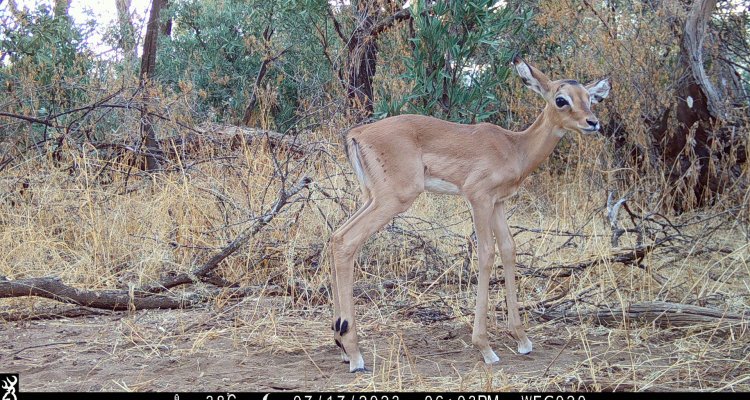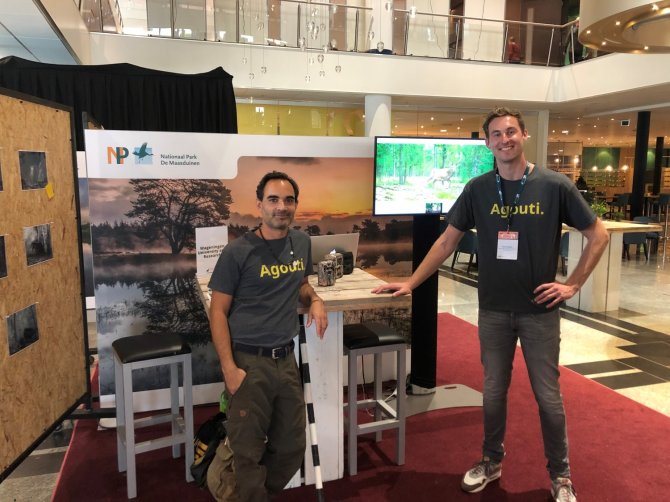
News
Deer or boar? Agouti helps determine species in millions of images
Wildlife cameras today are in all sorts of places: in nature reserves and gardens, on ecoducts, on rocks by the sea, next to a dead animal or in an agricultural solar park. The images from these cameras can be managed in the platform Agouti. Artificial Intelligence (AI) helps analyse the images.
In 2009, Yorick Liefting and Patrick Jansen studied Central American mammals using wildlife cameras. Manually viewing and processing the many thousands of pictures was a time-consuming task. So in collaboration with INBO, they began developing software to manage and efficiently analyze images. When fellow researchers showed interest in the software, they decided to open up the platform.
The new platform was named after the then most commonly observed species: Agouti, and in 15 years grew from one to nearly a thousand projects. Now Liefting is a research associate in the Wildlife Ecology and Conservation chair group and an administrator and developer of Agouti. Patrick Jansen is senior lecturer and project leader there. Since spring 2023, Ruud Borgart of Corporate Value Creation has been hooked up with the goal of future-proofing Agouti so that the platform can grow into the premier wildlife camera solution.

What is Agouti?
Liefting: "Agouti is software that processes images from motion-sensing wildlife cameras. These types of cameras have become rapidly popular with scientists and wildlife managers in recent years. With wildlife cameras you can collect essential information about animal populations. Which species occur where, and in what numbers? How do they spread out? What behaviours do they exhibit? Of course, you can enter this kind of data associated with those images by hand. But it can also be done much more efficiently, so a small part by hand and the rest automatically.
An important goal of Agouti is to prevent images collected all over the world from being lost. To do this, it must be processed in a proper and standardized way and stored in a so-called data repository. Agouti helps with all these tasks, and encourages researchers to process and store their data neatly.'
How does Agouti recognise different animal species?
Liefting: 'We are hitching a ride on innovations that you now have in the field of Artificial Intelligence (AI). This field is developing at lightning speed. Techniques that were previously just theory are now coming within reach of ecologists. In other words, the step has been made from algorithm in a scientific paper to a system that allows users to automatically identify species with the click of a mouse.'
Borgart: "Agouti uses neural networks. Such a network consists of many layers and looks for patterns in the image. To build such a network you work with a labelled data set, in this case images of which the species is known. You divide this dataset into two parts: one part to build the network and another part to test afterwards how well the model works.
This is called a training process, and you repeat it just as many times until the network learns to recognise the species correctly. In other words, what percentage of photos with a deer are correctly recognised by the model as deer? If this percentage is high enough for enough species, you can also start applying the model to images where it is not yet known what is on them. And in the latter lies the enormous gain for researchers.'
So at one point, the platform contained mostly agoutis, but now it contains images of snow leopards, boars, cheetahs, deer and all sorts of other species. Why do all these researchers and wildlife managers choose Agouti to manage and analyse their images?
Liefting: 'Mainly because you can answer certain questions easier and faster. National Park De Hoge Veluwe, for example, has had dozens of wildlife cameras for years. These provide an enormous amount of data about where animals are and how many of them there are. For example, park managers want to know how deer use their habitat, and whether they behave differently now that the wolf is there.
Many of the images are tagged via crowd sourcing, that is, with volunteers in the High Veluwe Snapshot project. That works, but there are a few million of them and it still proves difficult to keep people motivated for long periods of time. AI can take some of the repetitive work off their hands, because in 60 to 80 percent of the photos with animals, the animal looks good enough to be reliably recognised.
Sometimes it is even more urgent and topical, as African swine fever is making inroads across Europe. To deal with that, you have to model how the disease can spread. Essential information for that is where wild boar populations are and how large they are. The European Food Safety Authority (EFSA) wants to track this better, because now that information is scattered or not available at all. Then you need a central system like Agouti, in which all the data on mammal populations comes together, and with the help of AI can also quickly arrive at answers.'
Borgart: 'AI models thus help to find short-term answers to all kinds of questions about biodiversity loss and climate change. WUR has an enormous amount of knowledge, data and systems, but they often exist side by side. AI means acceleration. Now that there are more and more images in Agouti, the algorithm is getting better and better.'
So the more images, the better it works?
Liefting: "Yes, Agouti now has a dataset of 135 million images, part of which is used to train the AI system. It has also surprised me how fast the platform has grown. Every week about ten new interested parties sign up to use Agouti for their projects. Each researcher does still own and manage the dataset, but the AI algorithm learns each time with such a new dataset. And we do not exclusively offer our own AI; if someone else has created a useful model, we can include it in Agouti upon request. In this way, we let researchers choose what works best for their project.
Borgart: "The AI system was created by the collective. We need a huge number of images for an effective system, but in the meantime it's also about good infrastructure and data management.'

So how do you take care of that?
Liefting: 'For example, we have recently been working on better standards for data quality, also together with other institutions in this field. Researchers need to know how best to hang the cameras and what format the images should be in order to make use of the AI system. That is what we have now created the Camera Trap Data Package for. This standard is supported by the Global Biodiversity Information Facility. It is the next step in maturing Agouti and making the data FAIR.
By using Agouti, you automatically produce data that can be easily shared and published.'
Agouti has now been running for 15 years. How do you ensure that the platform continues to exist?
Borgart: 'It's not just about a system like Agouti working and making an impact, but we also have to look to the future. That's why the project has now received a grant from WUR to look for sustainable funding. Over the next 10 years, we want this to become one of the most relevant platforms for wildlife monitoring. We are going to professionalise and "market" Agouti. Not for profit, but to keep it on the air in a sustainable way.'